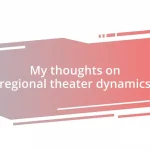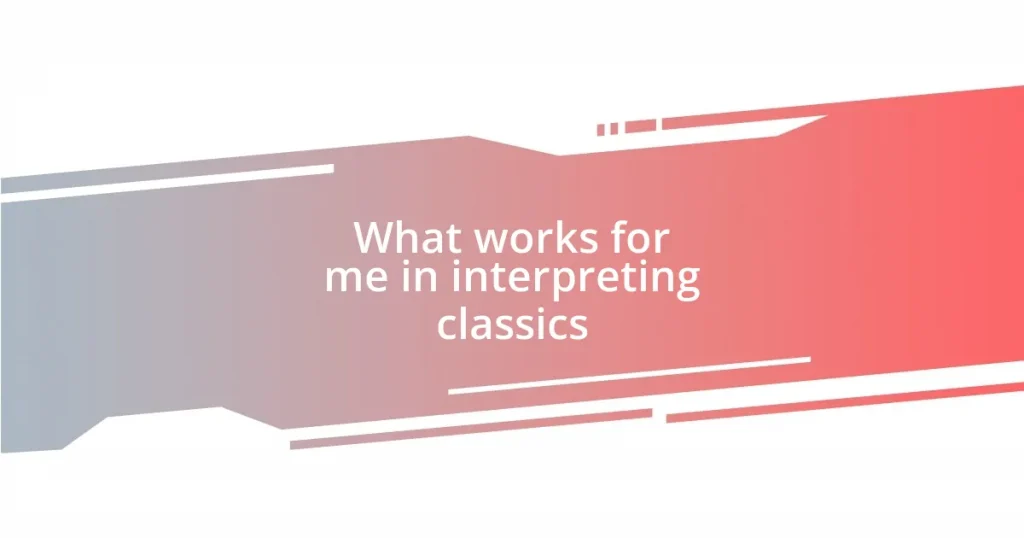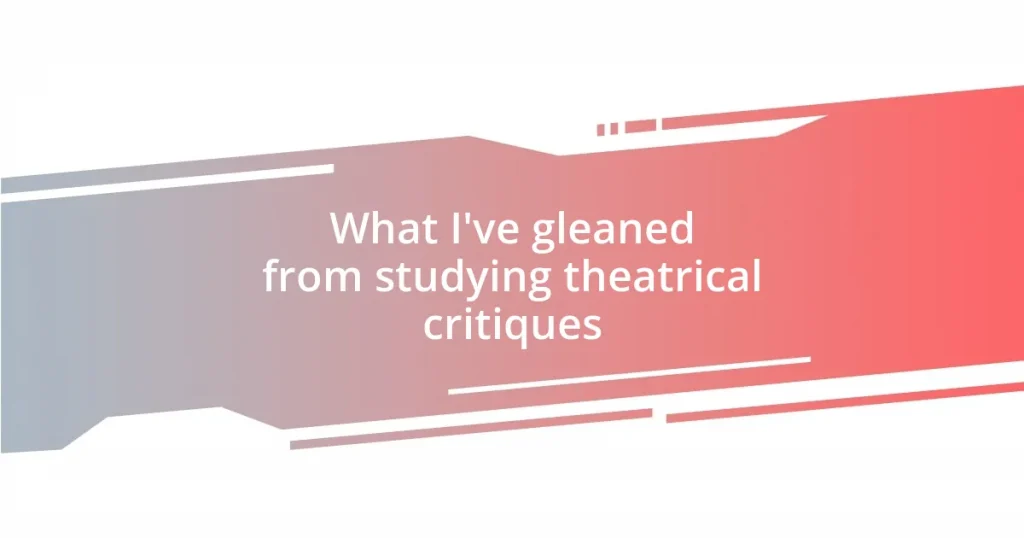Key takeaways:
- The director is a visionary who interprets the script and creates a collaborative environment, encouraging actors to contribute their insights.
- Key skills for directors include communication, collaboration, organization, adaptability, and empathy, all essential for cultivating a creative atmosphere.
- Choosing the right script involves evaluating its resonance with the cast and audience, ensuring accessibility and relatability.
- Effective rehearsals focus on intention, emotional depth, and physicality, fostering a supportive space for innovation and experimentation.
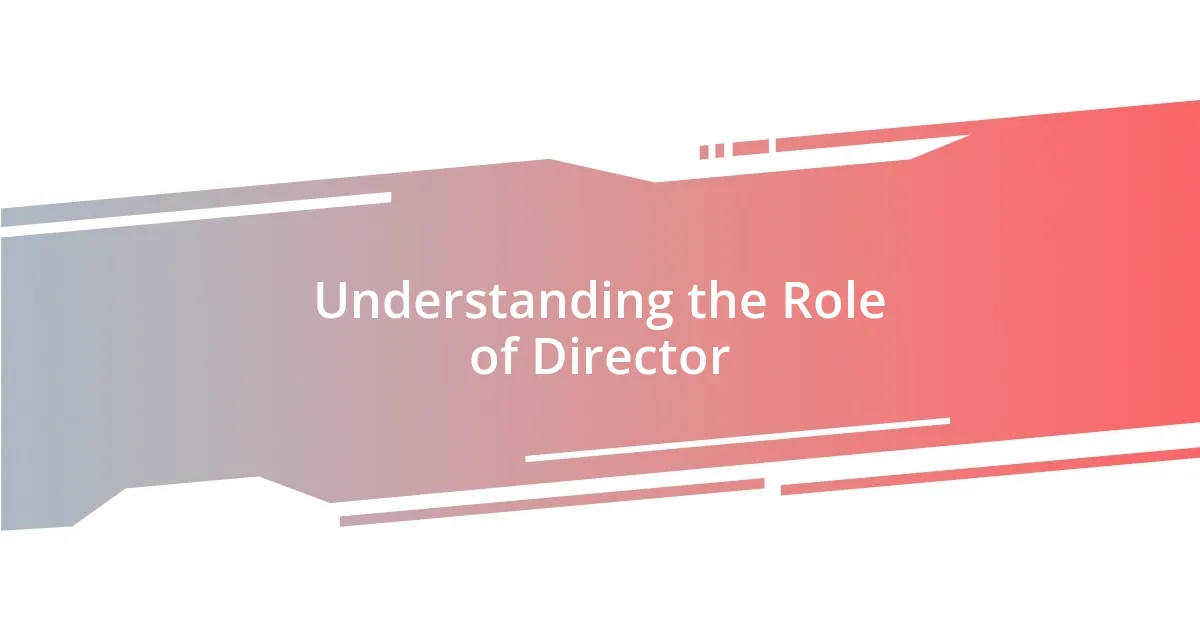
Understanding the Role of Director
The director plays a pivotal role in bringing a script to life, acting as the visionary who interprets the text and shapes the overall artistic vision. I remember my first experience directing a small production; it was exhilarating to witness how my interpretation influenced the actors’ performances and the audience’s responses. This responsibility also raises questions: How do you balance your vision with the actors’ insights?
A director must also cultivate an environment of collaboration, making the rehearsal space a safe haven for creativity. I’ve found that when actors feel empowered to share their ideas, the production flourishes in unexpected ways. It’s fascinating how a cast can transform your initial concept into something greater, don’t you think? The ability to listen and adapt is just as crucial as setting the tone.
Moreover, the director serves as the bridge between the creative team and the audience. In my own journey, I’ve often discovered that the most effective direction involves constant reflection on the audience’s perspective. How can we evoke emotion, provoke thought, and ensure the story resonates? This delicate balance is what makes directing in theatre an art form in itself.
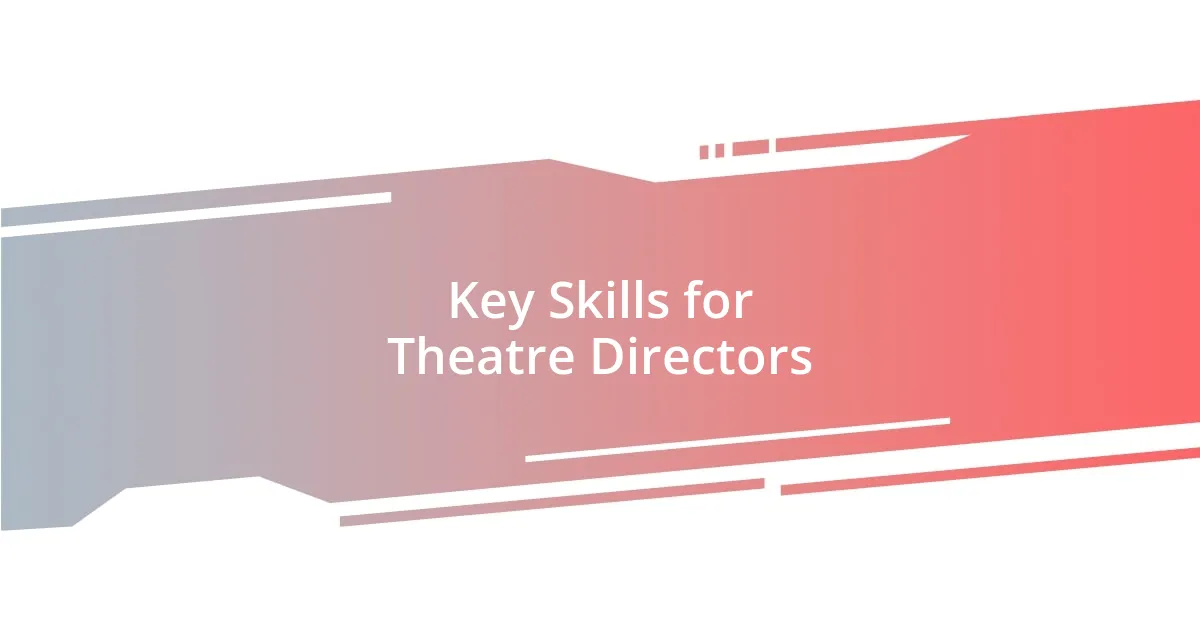
Key Skills for Theatre Directors
Directing theatre requires a unique blend of skills that go beyond mere artistic vision. One key skill is communication. Clearly articulating your vision to the cast and crew can make or break a production. I remember a particularly tough rehearsal where I struggled to convey what I envisioned for a pivotal scene. Afterward, I prioritized open dialogues with my team, which not only clarified my thoughts but also inspired fresh ideas from the cast. This kind of back-and-forth fosters a strong collaborative spirit.
Additionally, a director must possess strong organizational skills. Balancing schedules, coordinating with designers, and managing rehearsals can be overwhelming. I’ve learned that maintaining a clear workflow is paramount. Here’s a quick rundown of essential skills I believe every theatre director needs:
- Communication: Effectively share your vision while encouraging feedback.
- Collaboration: Foster a team environment where ideas thrive.
- Organization: Keep track of schedules, budgets, and creative notes.
- Adaptability: Be ready to shift direction based on new insights.
- Empathy: Understand the emotional journeys of actors and audience members.
By honing these skills, a director can cultivate a creative atmosphere that breathes life into the script.
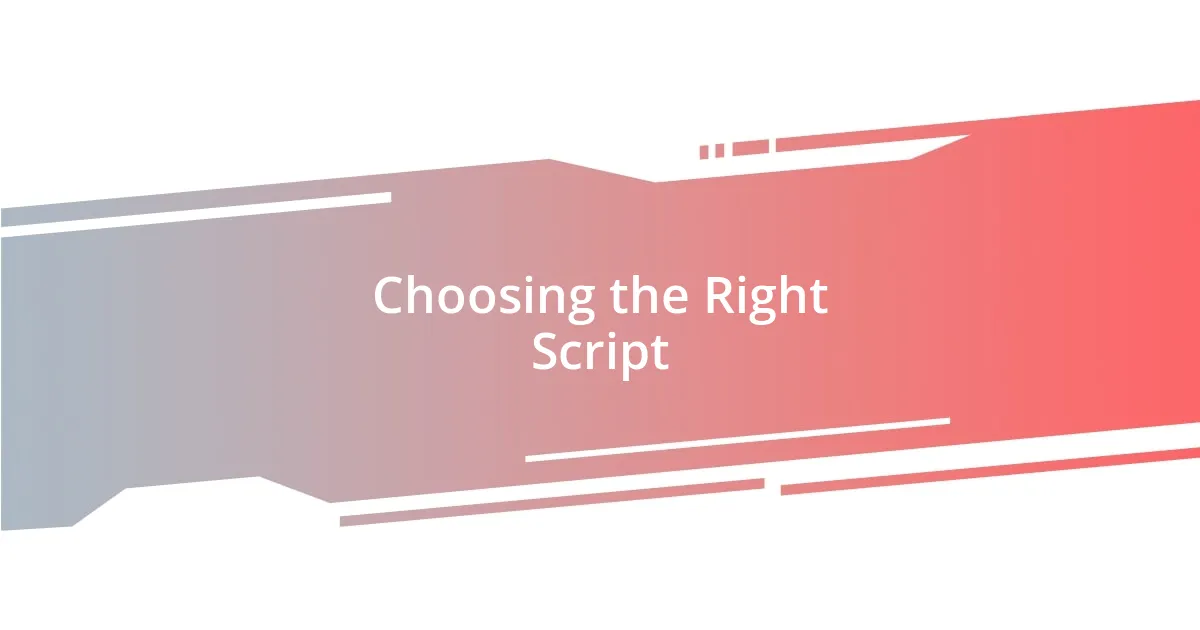
Choosing the Right Script
Choosing the right script is the foundation upon which a successful production is built. I learned this the hard way during a project where I was overly excited about a complex piece that simply didn’t resonate with my cast. Our rehearsal room, usually buzzing with energy, turned into a space filled with frustration. I realized that selecting a script isn’t just about the page; it’s about how it speaks to the actors and audience alike. Finding a script that ignites passion in the cast can transform the entire atmosphere of a production.
When considering your options, think about the strengths and weaknesses of your ensemble. In my experience, I once directed a historically rich play. The actors, instead of being intimidated by the material, found their groove and brought a fresh vibrancy to the characters. I can’t stress enough how essential it is to evaluate potential scripts against the talent you have at your disposal. You’ll often find that the best choices allow your cast to shine, showcasing their unique abilities while harmonizing with the storyline.
Ultimately, engaging with the audience’s experience should also play a critical role in your selection. I recall reading a script that was profound yet obscure. While I admired its literary merit, I quickly realized it would alienate the audience. Before making a choice, consider asking yourself: Will the audience connect with this story? You may save yourself a lot of headaches by prioritizing accessibility and relatability in the scripts you choose.
| Criteria | Considerations |
|---|---|
| Theme | Does the script convey a message that resonates? |
| Cast Fit | Are the characters suited to the actors’ strengths? |
| Audience Engagement | Will the audience relate to and appreciate the narrative? |
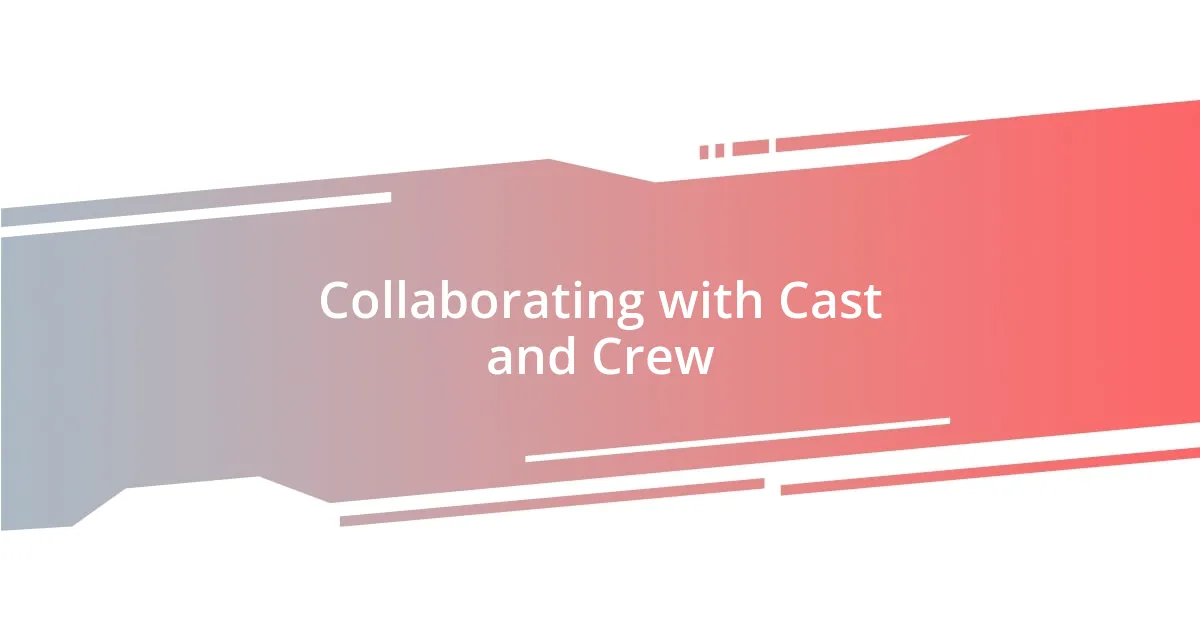
Collaborating with Cast and Crew
Collaboration with the cast and crew is like orchestrating a beautiful symphony, where each member plays a pivotal role. I often think back to a production where we faced a major setback—our lighting designer fell ill just days before opening night. Rather than panic, we all came together, pooling ideas and resources to adapt. That experience really underscored for me how essential it is to create an environment where everyone feels comfortable sharing their insights and stepping up when needed.
One memorable moment occurred during a rehearsal when an actor suggested a modification that completely transformed a scene. Initially, I hesitated; it felt risky to shift something I had envisioned so clearly. But as I listened, I realized that trusting my team’s instincts can lead to unexpected brilliance. It made me wonder—how many times do we stifle creativity by clinging too tightly to our own ideas? A director’s role isn’t just to lead; it’s to facilitate an atmosphere where innovation thrives and diverse perspectives are valued.
I find that building strong relationships within the team lays the foundation for collaboration. During one project, I made it a point to have casual check-ins with the cast and crew over coffee. This simple gesture opened the doors to conversations that went beyond the script. People shared personal stories and experiences that fed into their performances, making the final show more authentic and relatable. It’s moments like these that remind me collaboration is about connection—between the director, cast, and crew, ultimately leading to a richer theatrical experience for everyone involved.
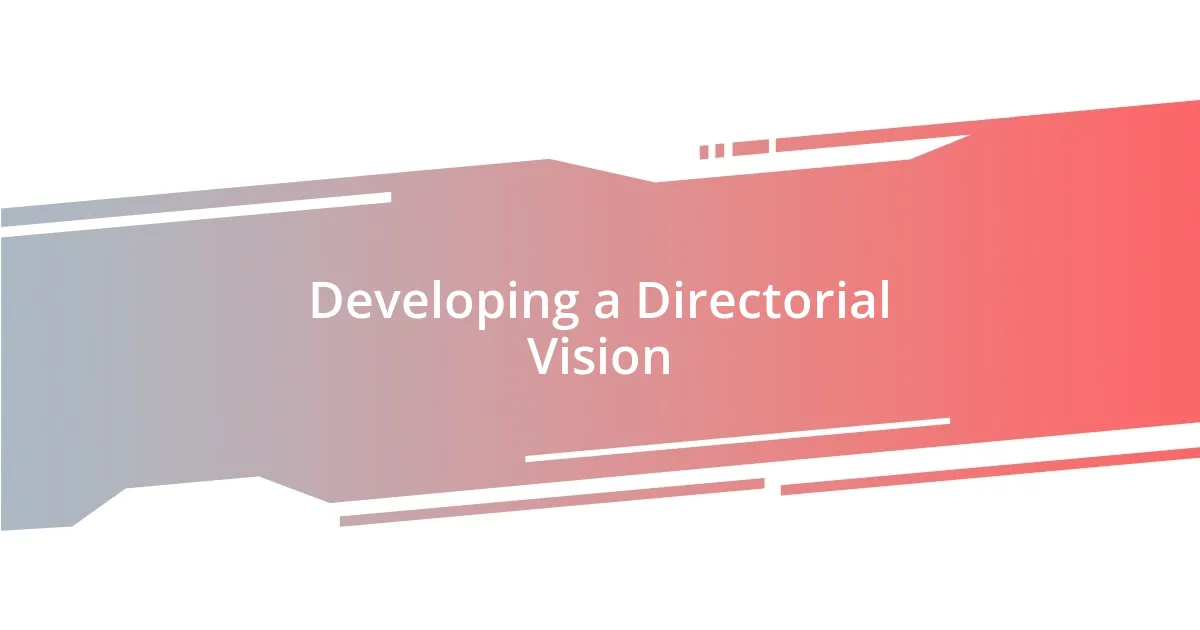
Developing a Directorial Vision
Developing a directorial vision is an exhilarating journey that requires deep introspection and bold creativity. I vividly remember a time when I struggled to articulate my vision for a production. I felt overwhelmed by the myriad of approaches I could take. It was through sketches and mood boards that I finally crystallized my ideas. This visual representation not only anchored my thoughts but also provided a tangible reference for my team. Have you ever found that an image can convey what words sometimes cannot?
I’ve learned that imbuing your vision with personal experiences can make it resonate more authentically. For instance, while directing a contemporary play, I drew on my own struggles with identity, weaving those themes into the characters’ arcs. It surprised me how these reflections opened up conversations with my cast, fostering a deeper investment in their roles. I like to ask myself—what stories do I carry that could enhance the narrative? This connection can transform a directorial vision into a shared journey that all involved can explore together.
Creating a vision is not just a one-time activity; it’s an evolving process. During my last production, I encouraged constant feedback sessions where the cast could voice their impressions. It was enlightening to witness a simple scene transform as we layered in ideas from diverse perspectives. I’m always amazed at how much a single viewpoint can breathe new life into a stagnant concept. So, I think it’s crucial for directors to remain open-minded—how often do we allow others to help shape our creative visions? Embracing that collaboration not only enriches the work but also fosters a sense of unity within the team.

Techniques for Effective Rehearsals
Effective rehearsals are the backbone of any successful production, and I’ve always found that setting a clear intention for each session can make all the difference. For instance, during a rehearsal of a complex drama, I decided to focus exclusively on emotional beats, rather than blocking. This choice allowed the actors to delve deeply into their characters, leading to breakthroughs that might not have happened if we’d concentrated solely on choreography. Have you ever noticed how sometimes, peeling back the layers yields the greatest insights?
I also believe in the power of creating a supportive atmosphere where actors feel safe to experiment and make mistakes. I recall a particularly challenging rehearsal where one of my actors struggled with a crucial monologue. Instead of pushing through, I encouraged the entire cast to share their interpretations of the lines. Watching them collaborate was incredible; it gave birth to a range of ideas and highlighted the importance of vulnerability in performance. How often do we let fear stifle our creativity during rehearsals?
Finally, incorporating physicality in rehearsals is a technique that I swear by. In one production, we dedicated a day to exploring movement, allowing the actors to respond to the text through their bodies. That day turned into a revelation; they discovered new layers to their characters that expanded beyond words. I’ve learned that when we engage with the text physically, it unlocks a different realm of understanding. Isn’t it fascinating how movement can sometimes express what words cannot articulate? These techniques, when thoughtfully integrated, can transform the rehearsal process into an exhilarating adventure for everyone involved.

Evaluating Performance and Feedback
Evaluating performances and providing feedback is an essential part of the directorial role. I remember a particular run-through where the energy just felt flat. It struck me how vital it was to create space for honest dialogue; after the performance, I invited everyone to share their thoughts. This openness not only broke the ice but also revealed unique perspectives that shaped our next rehearsal. Have you ever felt that a few genuine words can completely shift the direction of a project?
When giving feedback, I strive to balance constructive criticism with encouragement. In one memorable instance, an actor performed beautifully but missed a crucial emotional cue. Instead of pointing it out directly during the session, I framed my feedback as a collaborative exploration. I asked, “What if we revisited that moment? How might it feel if you approached it from a different emotional angle?” That sparked an insightful discussion, and together we discovered a deeper layer to the character. Isn’t it amazing how reframing a critique can transform it into an opportunity for growth?
I also find that timing feedback can be just as important as its content. After a particularly emotional scene in a recent play, I sensed it would be counterproductive to dive into critique right away. Instead, I allowed the moment to settle, giving everyone a chance to breathe. Later, in our next session, we had a relaxed discussion about the scene, and the actors were more receptive to feedback. I wonder, how often do we consider the emotional state of our team when evaluating their work? It’s these small nuances that can make a significant difference in how we collectively evolve as artists.







